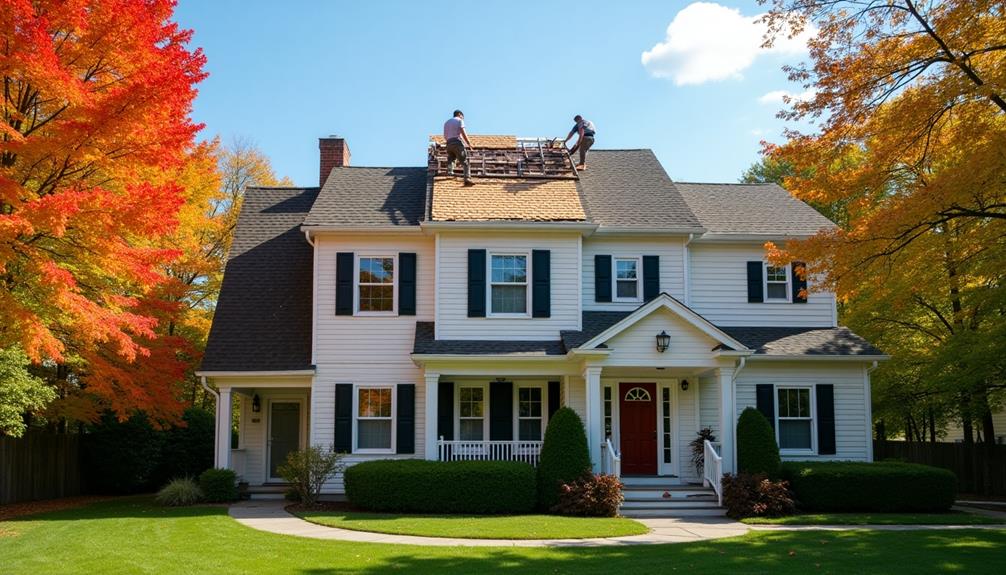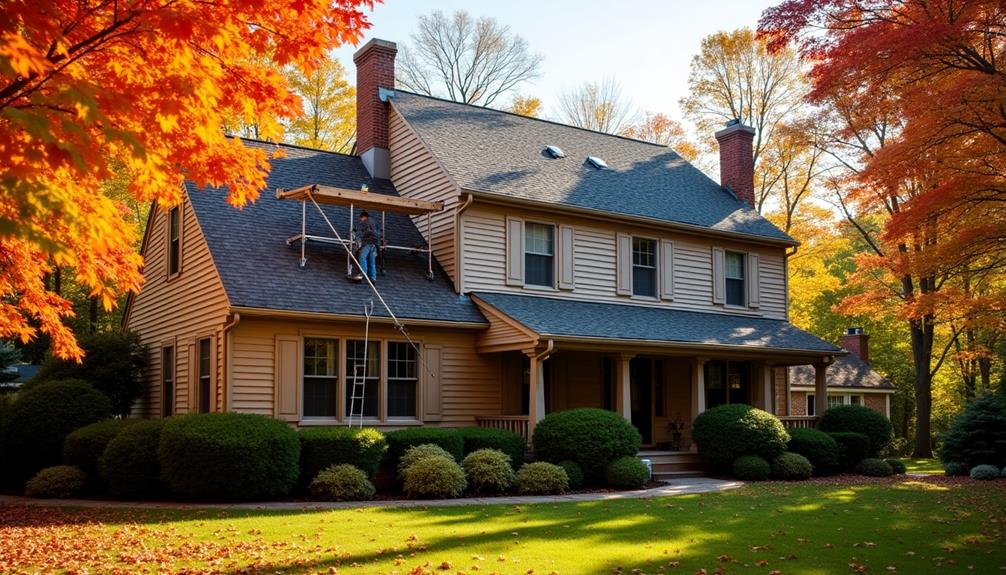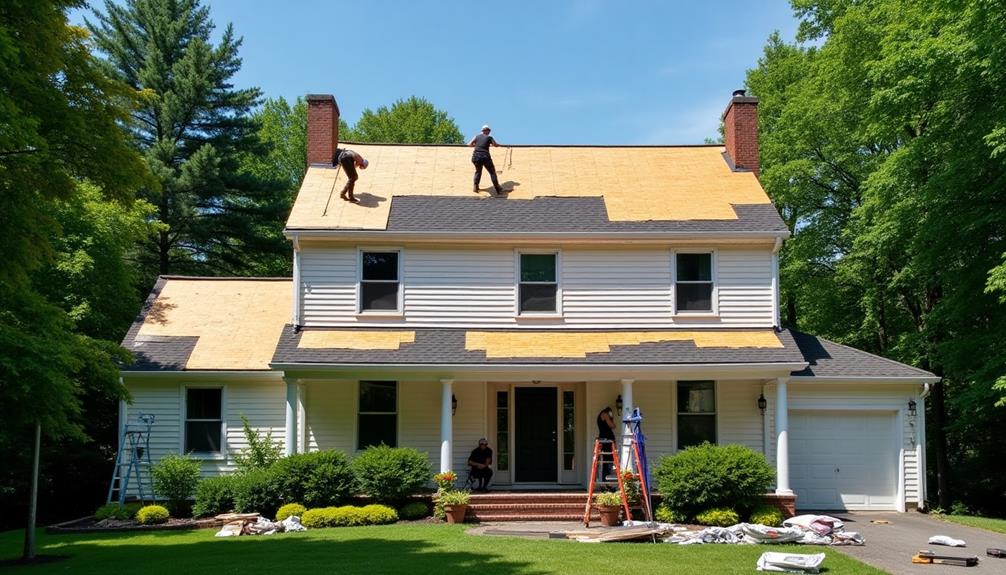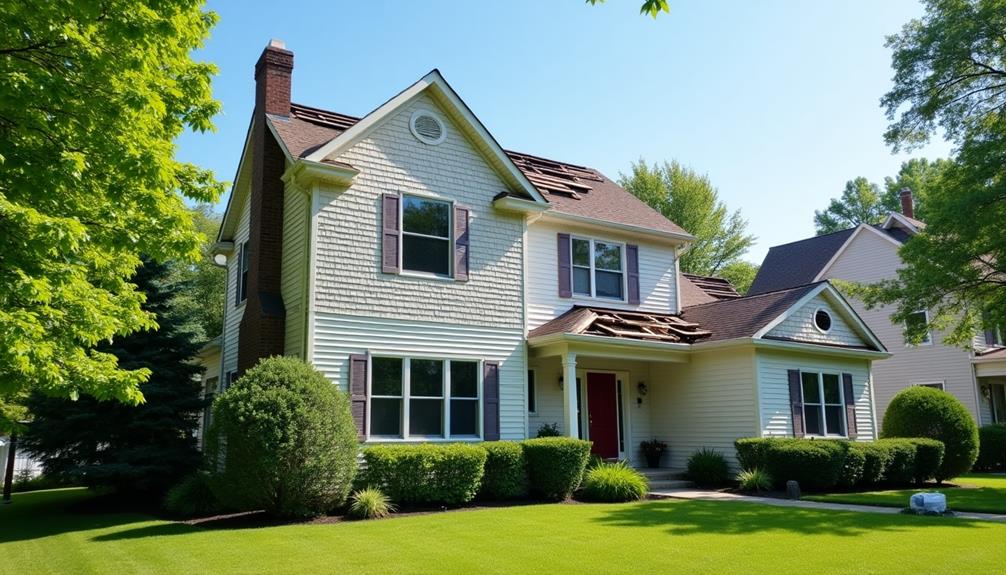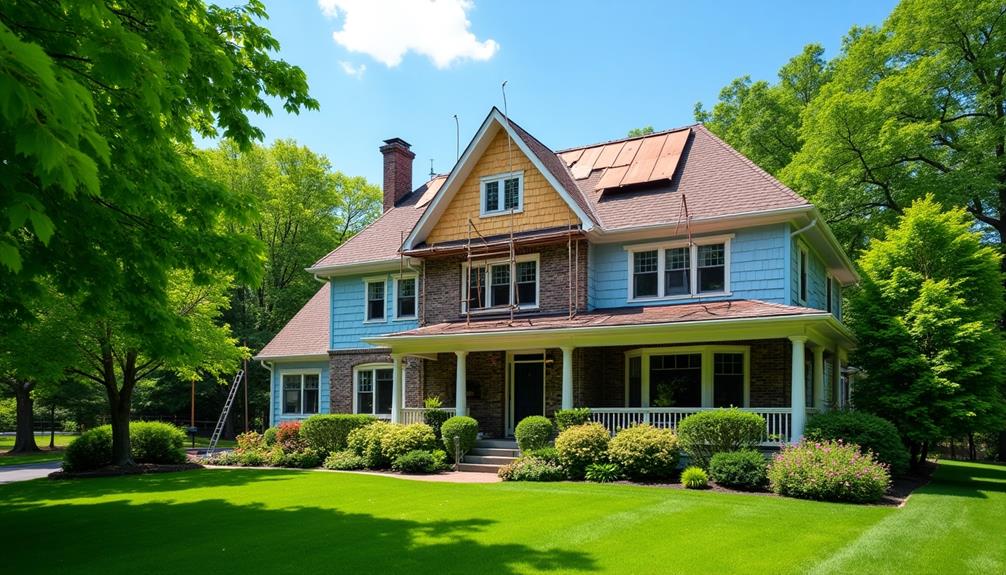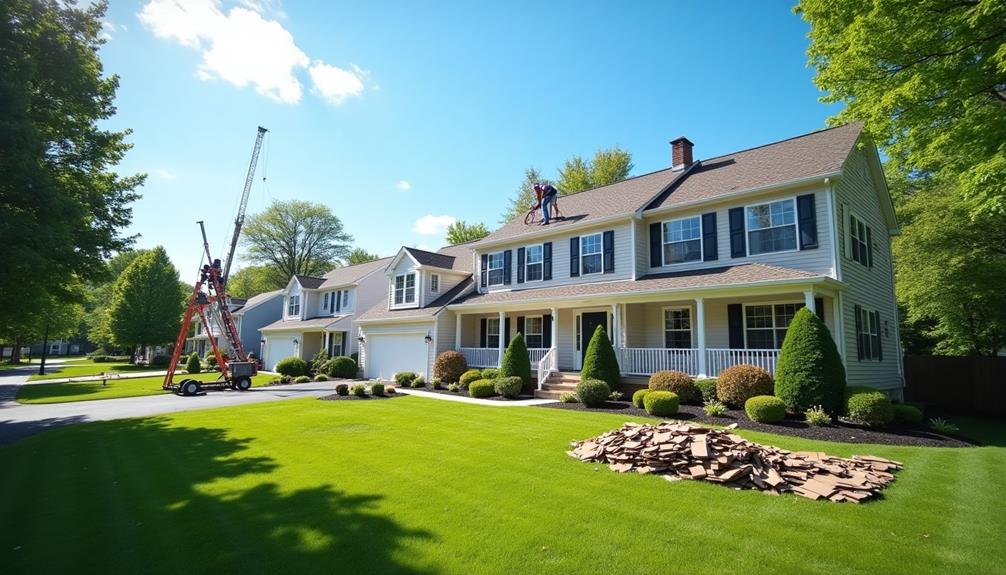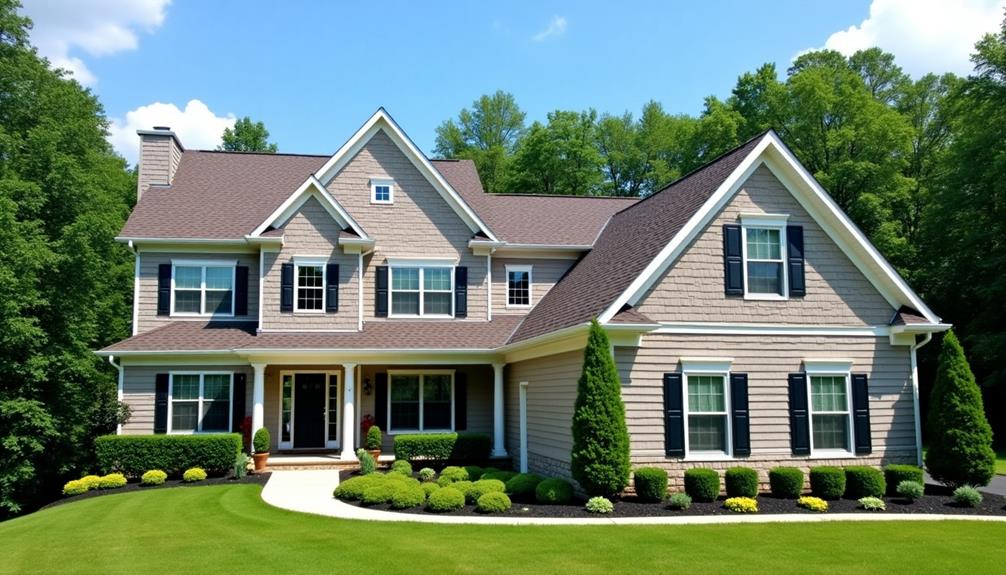If you're considering roof replacement in Livingston, NJ, you're focusing on both protection and value. Your roof typically lasts 15 to 30 years, so recognizing signs like missing shingles or water stains is crucial. Choose materials that suit the local climate—think asphalt for cost-effectiveness or metal for longevity. It's essential to hire licensed contractors who follow New Jersey's regulations and can handle unexpected issues. Proper installation boosts performance and extends lifespan. To ensure a smooth process and lasting results, it's wise to know the steps involved in preparation and maintenance. There's much more to explore on ensuring your roof's success.
Understanding Roof Replacement
When it comes to roof replacement, understanding the process is crucial for homeowners in Livingston, NJ. A roof is a significant investment, and knowing the installation process can help you make informed decisions. The average roof lifespan varies depending on materials and local weather conditions, but typically ranges from 15 to 30 years. Regular maintenance can extend this lifespan, but eventually, replacement becomes necessary.
The installation process begins with an assessment of your current roof's condition. This involves a detailed inspection to identify any underlying issues that could affect the new roof.
Once you've selected the right materials—be it asphalt shingles, metal roofing, or tiles—the next step is to prepare your home for the installation. This includes securing permits and scheduling the work.
During installation, skilled professionals will remove the old roofing, inspect the underlying structure, and install the new materials following local building codes. Proper installation is vital to ensure your new roof performs effectively and lasts as long as possible.
Signs You Need a New Roof
Recognizing the signs that indicate you need a new roof can save you from costly repairs and further damage to your home. Over time, roofs experience wear and tear, impacting their lifespan. Here are some key indicators that it's time to consider a replacement:
| Sign | Description |
|---|---|
| Shingle Damage | Curling, missing, or cracked shingles can compromise your roof's integrity. |
| Water Stains | Dark spots or stains on your ceilings signal potential leaks and water damage. |
| Granule Loss | Excess granules in your gutters indicate shingles are deteriorating. |
Performing regular leak detection is essential to catch issues early. If you notice any of these signs, don't wait for the problem to escalate. A roof nearing the end of its lifespan is more susceptible to leaks and damage, which could lead to more extensive repairs. By addressing these issues promptly, you'll not only protect your home but also maintain its value. If you're unsure about your roof's condition, consulting a professional can provide clarity on the necessary steps.
Choosing the Right Materials
When selecting materials for your roof replacement, you'll want to consider durability, climate effects, and aesthetic appeal.
Each material reacts differently to weather conditions, which can impact its longevity and your home's appearance.
Making informed choices will ensure you get a roof that not only stands the test of time but also enhances your property's value.
Material Durability Considerations
Choosing the right materials for your roof replacement in Livingston, NJ, involves more than just aesthetics; it's crucial for ensuring long-term durability and performance. You'll want to prioritize material longevity and weather resistance to protect your investment effectively. Different materials offer varying degrees of durability, so understanding your options is essential.
Here's a quick comparison of popular roofing materials:
| Material Type | Material Longevity | Weather Resistance |
|---|---|---|
| Asphalt Shingles | 15-30 years | Moderate |
| Metal Roofing | 40-70 years | High |
| Slate Roofing | 75+ years | Very High |
| Wood Shakes | 20-40 years | Moderate |
As you evaluate these options, consider factors like local climate, your budget, and maintenance requirements. Metal roofing, for instance, offers exceptional longevity and can withstand severe weather conditions, making it a smart choice for long-term value. On the other hand, asphalt shingles are more budget-friendly but may not hold up as well over time. By making an informed decision, you can ensure your new roof provides the durability and performance necessary to withstand the elements for years to come.
Climate Impact on Choices
Understanding the impact of climate on your roofing material choices is essential for ensuring a roof that lasts. In Livingston, NJ, where weather patterns can vary significantly, selecting the right materials is crucial for maximizing energy efficiency and minimizing environmental impact.
When you choose materials that align with your local climate, you can enhance your roof's performance. For instance, reflective roofing materials can reduce heat absorption during summer months, significantly lowering your cooling costs. Conversely, materials with better insulation properties can keep your home warm in winter, improving energy efficiency year-round.
Additionally, consider the environmental impact of your roofing choices. Opting for sustainable materials, like metal or recycled shingles, not only supports eco-friendly practices but often comes with long-term durability, reducing the frequency of replacements.
Assessing the climate also helps you determine which materials can withstand local weather phenomena, such as heavy rain or snow loads. By making informed decisions based on climate considerations, you'll invest in a roof that not only protects your home but also contributes positively to the environment and your wallet in the long run.
Aesthetic Appeal Factors
A well-chosen roof can significantly enhance your home's curb appeal, making it vital to consider aesthetic factors alongside functionality. When selecting roofing materials, think about how they complement your home's architectural style and existing color schemes. The right materials can unify your home's appearance and create a cohesive look that attracts attention.
Here's a brief overview of popular roofing materials and their aesthetic appeal:
| Roofing Material | Best Suited Color Schemes | Ideal Architectural Styles |
|---|---|---|
| Asphalt Shingles | Neutrals, Earth Tones | Colonial, Ranch |
| Metal Roofing | Bold Colors, Pastels | Modern, Contemporary |
| Slate Tiles | Dark, Rich Colors | Traditional, Gothic |
Choosing the right roofing material is more than just a practical decision; it's an investment in your home's overall look and feel. By selecting materials that align with your color scheme and architectural style, you not only enhance your home's aesthetic appeal but also increase its value. Don't underestimate the power of a well-designed roof—it's a key element of your home's exterior charm.
Local Climate Considerations
Livingston, NJ experiences a diverse climate that significantly impacts roof replacement decisions. With hot summers and cold winters, you need a roofing system designed to withstand temperature fluctuations and precipitation. Choosing the right materials is crucial for energy efficiency; they should reflect sunlight in the summer while providing insulation during winter months. This balance can help reduce your energy bills and maintain comfort in your home.
Roof ventilation is another vital aspect to consider. Proper ventilation allows for air circulation, reducing moisture buildup that can lead to mold or structural damage. In summer, it helps dissipate heat, enhancing the overall energy efficiency of your home. During winter, adequate ventilation prevents ice dams, which can cause severe damage to your roof and gutters.
When replacing your roof, prioritize materials that offer durability against harsh weather conditions while also promoting energy efficiency. By considering the local climate, you'll not only ensure the longevity of your roof but also create a more sustainable living environment.
Ultimately, these decisions will protect your home and save you money in the long run.
Budgeting for Roof Replacement
When planning a roof replacement, it's important to have a clear budget in mind. Start by assessing the overall cost of materials, labor, and any additional expenses that might arise.
Consider the type of roofing material you want; options like asphalt shingles, metal, or tile vary significantly in price. Don't forget to factor in potential unexpected costs, such as structural repairs or permits.
Next, explore your financing options. Many roofing companies offer payment plans, and some even have partnerships with financing institutions that can provide loans specifically for home improvements.
This can ease the immediate financial burden and allow you to manage payments over time.
Additionally, check your insurance coverage. If your roof has sustained damage due to a covered event, your homeowner's insurance may help offset costs.
Document any damage and consult your insurance agent to understand your coverage limits and deductibles.
Finding Reliable Contractors
Finding a reliable contractor for your roof replacement can feel overwhelming, but it's crucial for ensuring a successful project. To help streamline your search, focus on contractors who meet specific criteria. Here's a quick reference table to guide you:
| Criteria | Importance | How to Verify |
|---|---|---|
| Contractor Reviews | Assess past performance | Check online platforms |
| Licensing Requirements | Ensure compliance with state laws | Request copies of licenses |
| Insurance Coverage | Protect against liability and risk | Verify certificates |
Start by reading contractor reviews on websites like Yelp or Angie's List. These insights can reveal important details about their work ethic and quality. Additionally, confirm that potential contractors meet licensing requirements in New Jersey, as this ensures they adhere to local regulations and standards.
Lastly, don't forget to check for proper insurance coverage. This protects you from potential liabilities during the project. By following these steps, you'll be well-equipped to find a reliable contractor who meets your roof replacement needs. Taking the time to research now can save you headaches later.
Questions to Ask Contractors
Once you've narrowed down your list of potential contractors, it's time to engage them with thoughtful questions. Start by asking about their contractor qualifications. You want to ensure they've the necessary licenses, insurance, and certifications to perform the work safely and legally.
Inquire about their experience with roof replacements similar to yours, as this can significantly impact the quality of the job.
Next, discuss project timelines. Ask how long the roof replacement will take, from start to finish. A reliable contractor should be able to provide a clear estimate, detailing each phase of the project. This not only helps you plan but also sets expectations on when you'll see the completion.
Additionally, inquire about their process for handling unexpected issues that may arise during the project. Understanding how they approach challenges will give you confidence in their problem-solving abilities.
Preparing for Roof Installation
Preparing for a roof installation involves careful planning and organization to ensure a smooth process. Start by scheduling a thorough roof inspection. This step identifies any underlying issues that might affect the installation, such as structural damage or moisture problems. Addressing these concerns beforehand can save you time and money in the long run.
Next, establish a realistic installation timeline with your contractor. Understanding how long the project will take allows you to plan accordingly, minimizing disruptions to your daily routine. Discuss potential weather delays with your contractor, as inclement weather can impact the schedule.
Additionally, prepare your home and yard for the installation. Move vehicles away from the work area and clear any outdoor furniture or decorations. This not only protects your belongings but also provides contractors with easy access to your roof.
Maintenance Tips After Replacement
Your new roof is an investment that requires ongoing care to ensure its longevity and performance. To protect that investment, prioritize routine inspections at least twice a year. Look for missing shingles, signs of wear, or any debris that could affect drainage. Addressing small issues promptly can prevent costly repairs down the line.
Seasonal cleaning is also essential. In the fall, clear away leaves and branches that can trap moisture and lead to mold growth. In spring, check for any winter damage and clean gutters to ensure proper water flow. Clogged gutters can cause water to back up, potentially damaging your roof and home.
Don't overlook the importance of ventilation. Proper airflow helps prevent heat buildup in the attic, which can lead to premature roof deterioration. Ensure vents are unobstructed and functioning.
Lastly, consider scheduling a professional inspection after severe weather events. Storms can cause hidden damage that may not be immediately apparent.

